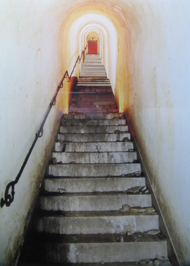bunker
documentation center
berchtesgaden land
on the border of austria
bavaria, Germany
europe
november 3, 2011


bunker
documentation center
berchtesgaden land
on the border of austria
bavaria, Germany
europe
november 3, 2011


The Bunker, constructed beneath Berchtesgaden Land above Obersalzberg, lies unfinished below ground, adjacent to the modern building that was constructed as a Documentation Center in the 1990’s. These grounds had at one time held the former grand complex of buildings that housed Hitler, his SS troops and officers, a place where Hitler entertained heads of state before and during World War II. After the Battle of Stalingrad ended the Nazi aura of invincibility, and the Allied bombing campaign over the Third Reich became a reality in 1943, this underground town was planned and engineered using slave labor to dig the tunnels through solid rock. Martin Bormann was forced to order the construction of a series of bunkers. Four miles of tunnels, built as protective air raid shelters, were protected by machine guns at each entrance, as well as a system of air locks in order to make the system gas-proof. A relative overpressure system was supposed to prevent poison gasses from entering the bunker system during entry or exit. Each air lock had an adjoining first-aid room to provide immediate assistance to anyone who might have been gassed. The labyrinth of tunnels also contained meeting rooms, offices, storage chambers for government archives, kitchens, store rooms, guest quarters, rooms for generators and engineering infrastructure, and more. Another shelter system built beneath Berghof included tastefully furnished rooms for Hitler and his mistress, Eva Braun. Bormann’s private shelter and another private bunker for Göring and his adjutant were built beneath Göring’s house. There was also a tunnel complex behind the Platterhof with a planned link to Hitler’s bunker and a less elaborate complex of tunnels on the periphery. The bunker system consisted of multi-level tunnels lined with concrete and bricks, with associated power, heating, and ventilation systems. The anti-aircraft defense center included a concrete tower containing a stairway leading to the surface, and also a periscope. In addition to the traditional air-raid tunnels, there were access tunnels linking several of the buildings on the Obersalzberg, as well as tunnels for ventilation, water, and sewage pipes. From beneath the Documentation Center, Henry and I were able to visit an impressive length of tunnels, many dripping with water and covered with mold, though most of the underground system is not accessible to the public. It was creepy visiting the tunnels, practically alone down there, at the end of the day, and we were relieved to see that a museum guard made a “sweep” of the area before closing down for the night. This Obersalzberg area had served as the second seat of Nazi administration during the war and was a place where Hitler met with his generals and visiting dignitaries. It was bombed by the Americans and the Royal Air Force on April 25, 1945 to prohibit the regime from continuing the war from the mountain retreat. This Bunker at Obersalzberg is not to be confused with the Führerbunker in Berlin, the place where Adolf Hitler and Eva Braun committed suicide.*
*Note and Post Script: The Berlin Führerbunker was constructed in two phases: 1936 and 1943. The Berlin bunker was the last of the Führer Headquarters to be used by Hitler and was the site of the dramatic end of the Third Reich. Hitler had taken up residence in the Führerbunker in January, 1945, and until the last week of the war it became the epicenter of the Nazi regime. On April 29, 1945, Adolf Hitler and Eva Braun were married in the map room within the Führerbunker. Hitler then took Traudl Junge to another room and dictated his last will and testament. Around 4 PM, Hans Krebs, Wilhelm Burgdorf, Joseph Goebbels, and Martin Bormann witnessed and signed the documents. here. Hitler then retired to bed. The following morning, April 30, the commander of the central government district of Berlin informed Hitler that the center would be unable to hold for two days; then Weidling, as commander of the Berlin Defense Area, informed Hitler in person that their ammunition would probably be exhausted that night, and asked permission to attempt a breakout. During the afternoon, Hitler shot himself and Eva Braun took cyanide. In accordance with Hitler’s instructions, the bodies were burned in the garden behind the Reich Chancellery. Following Hitler’s wishes as set out in his will, Joseph , Goebbels, the Minister for Public Enlightenment and Propaganda became the new Head of Government and Reichskanzler or Chancellor of Germany. Admiral Karl Dönitz was informed of Hitler’s death and was appointed the new Reichspräsident or “President of Germany”. By the end of the day, the Soviets had captured the Reichstag, which was of symbolic importance to the Soviets and one of the last German strong points defending the area around the Reich Chancellery and the Führenbunker. On May 1st, around 4 PM, Hans Krebs retuned from a meeting with General Vasily Chuikov, commander of the Soviet 8th Guards Army. Krebs returned empty handed after refusing to agree to an unconditional surrender. Only Reichkanzler Goebbels now had the authority to agree to an unconditional surrender. In the late afternoon, Goebbels had his children poisoned. At around 8 PM, Goebbels and his wife, Magda left the bunker. When they were close to the entrance, they bit down on a cyanide ampule and either shot themselves at the same time, or were given a coup de grâce by the SS guard detailed to dispose of their bodies. Early in the morning of May 2nd, the Soviets stormed the Reich Chancellery. General Weidling surrendered with his staff at 6 AM. General Burgdorf and General Krebs committed suicide leaving few people to be captured by the Soviets. About one dozen bodies of those who had committed suicide were found along with the ashes of burned documents.
PHOTOS: Top Three: 1. Descent from ground level into the bunker. Note the red door at the top of the stairway. 2. Detail: schematic plan and engineering map illustrating the labyrinth of underground tunnels dug for the bunker to protect Hitler and his inner circle. Middle Three: 1. Visitor’s guide illustrating the proximity of the bunker to the Documentation Center at Berchtesgaden. The arrows (top to bottom) indicate the following : a. Documentation Center (gray) b. Guesthouse Bunker (blue-gray) c. Platterhof Bunker (yellow) d. fragmented historical building (bright blue) and e. historic building with present-day usefulness. (light blue). 2. Exhibition photograph depicting an incomplete tunnel dug for the bunker. 3. Generator room, illustrating the total concept of the bunker as a long-term secret hideout for Hitler and his gang. Bottom Three: 1. Bormann’s Filing Room. 2. Tunnel with generators along the side. 3. Guesthouse bunker, now with exhibitions of Hitler and the Nazi regime.

Underground Shelter












